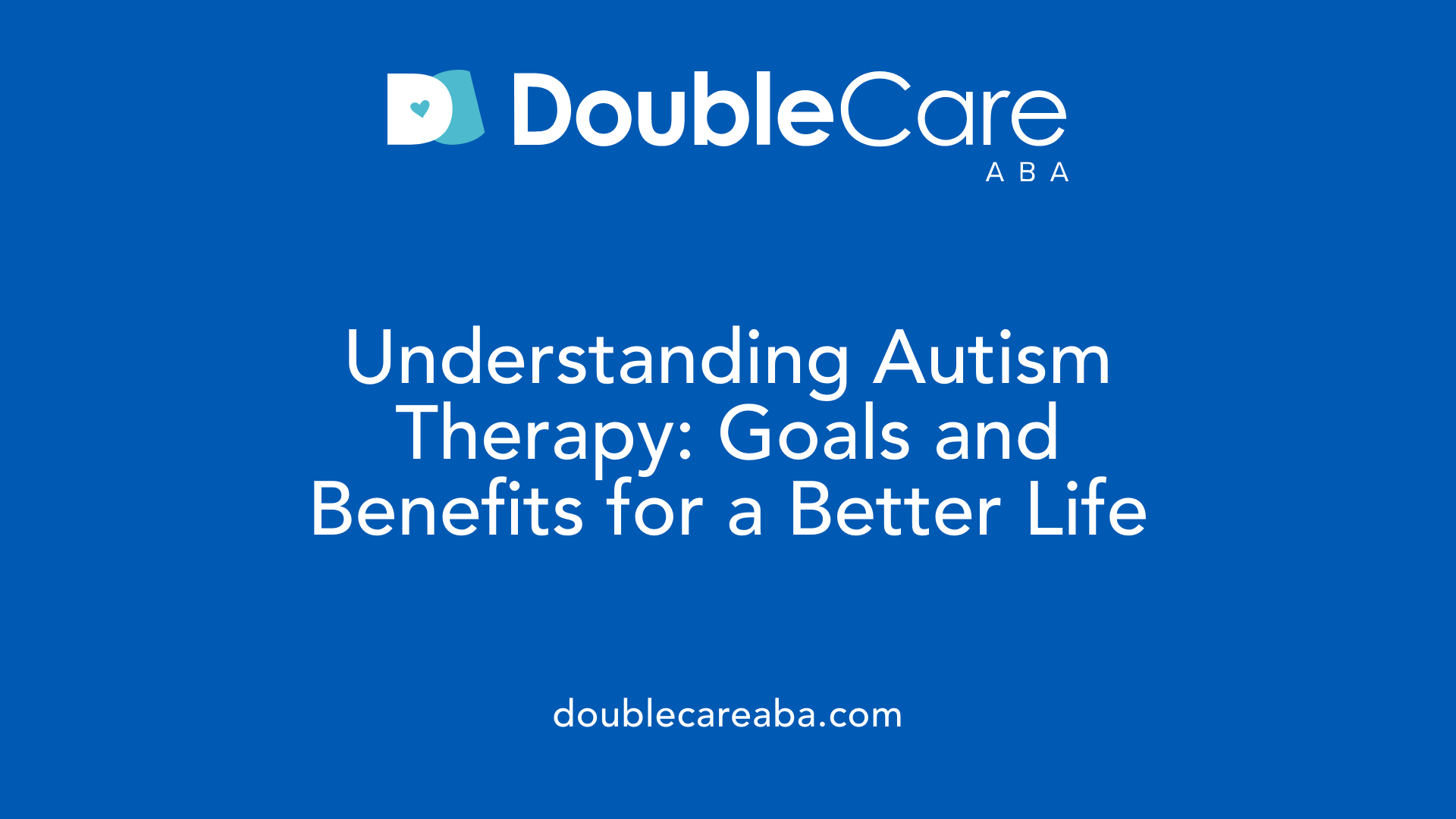Introduction to ABA Therapy and Its Role in Autism Support
Applied Behavior Analysis (ABA) therapy has become a cornerstone in autism treatment, helping individuals develop essential skills and navigate daily challenges. Central to delivering this highly specialized therapy are ABA therapists, professionals trained to apply behavioral science techniques tailored to each individual's needs. This article explores who ABA therapists are, what ABA therapy entails, the professionals involved, and the benefits and challenges of this widely recognized approach to autism support.
What Is Autism Therapy and How Does It Help Individuals with Autism?

Definition of autism therapy
Autism therapy refers to a variety of evidence-based treatments designed to support individuals with autism spectrum disorder (ASD). These therapies aim to improve social interaction, communication skills, behavior management, and everyday functioning tailored to the unique needs of each person.
Goals of autism therapy
The primary objectives include enhancing positive, helpful behaviors while reducing harmful or challenging ones. Therapy focuses on teaching functional skills such as communication, social engagement, self-care, play, and academic abilities, promoting independence and participation in society.
Common types of autism therapies
One of the most widely used approaches is Applied Behavior Analysis (ABA), which uses techniques like positive reinforcement and structured learning to encourage skill development. Other therapies include speech and occupational therapy, social skills training, and parent involvement programs. ABA itself incorporates methods such as Discrete Trial Training (DTT), Pivotal Response Treatment (PRT), and the Early Start Denver Model (ESDM), adapting to the child's interests and developmental needs.
Importance of early intervention
Starting therapy early, ideally before age 4, is crucial as young children's brains exhibit greater plasticity, allowing more effective learning and behavior change. Early, intensive therapy—often involving multiple hours per week—has shown significant improvements in communication, socialization, and adaptive skills.
Use of structured, personalized programs
Therapy programs are customized using comprehensive assessments conducted by certified behavior analysts, ensuring targets match individual strengths and areas for growth. These structured plans are adjusted regularly based on progress and help teach skills in natural settings like home or school.
Role of family involvement
Family members play a vital role by receiving training and support to help reinforce skills in daily life. Involving caregivers helps generalize learned behaviors beyond therapy sessions and creates a consistent, supportive environment.
Improvements therapy can bring
Individuals engaging in autism therapy often experience enhanced language abilities, improved social interactions, better self-care routines, and reduced negative behaviors. While autism is a lifelong condition, therapy can significantly boost quality of life, independence, and the ability to navigate various environments.
| Topic | Key Details | Additional Information |
|---|---|---|
| Definition | Evidence-based treatments for ASD support | Includes ABA, speech therapy, occupational therapy |
| Goals | Increase helpful behaviors, reduce harmful behaviors | Focus on social, communication, self-care, and academic skills |
| Therapy Types | ABA (DTT, PRT, ESDM), social skills training, parent involvement | Adapted to individual needs |
| Early Intervention | Best outcomes before age 4, therapy often 10-20+ hours weekly | Brain plasticity is greater in early years |
| Personalized Programs | Based on thorough assessment by behavior analysts | Programs target multiple skill areas and adjust over time |
| Family Involvement | Caregiver training supports skill generalization and consistent practice | Essential for progress in natural settings |
| Improvements | Gains in communication, social skills, independence, reduction in negative behaviors | Can enhance quality of life across the lifespan |
Understanding Applied Behavior Analysis (ABA) Therapy in Autism Treatment
What is Applied Behavior Analysis (ABA) therapy and how is it used in autism treatment?
Applied Behavior Analysis (ABA) therapy is a science-based approach focused on understanding and influencing behavior, particularly used to support children with autism and other developmental disorders. It operates by analyzing how behaviors are affected by the environment and applying strategies to increase helpful actions like communication, social skills, and self-care, while decreasing harmful or hindering behaviors.
What principles guide behavior analysis in ABA?
ABA relies on principles from behaviorism, including the use of positive reinforcement, which rewards a desired behavior to encourage its recurrence. Therapists identify the antecedent (trigger), behavior, and consequence (ABC) sequence to understand and modify behaviors effectively. This systematic approach helps tailor interventions to the individual's unique needs.
What are the goals and techniques of ABA therapy?
The primary goals of ABA therapy are to enhance social skills, promote independence, and improve daily functioning. Techniques include Discrete Trial Training (DTT), which offers structured learning; Pivotal Response Treatment (PRT), a play-based method that incorporates a child’s interests; and the Early Start Denver Model (ESDM), which blends play with traditional ABA methods. These approaches promote learning in engaging and naturalistic ways.
How are ABA treatment plans individualized?
Each ABA program is developed after comprehensive assessments by Board Certified Behavior Analysts (BCBAs). These evaluations ensure the therapy addresses specific skills such as communication, play, motor skills, and academics tailored to the individual's needs. Family involvement is also integral to support skill generalization across environments.
In what settings is ABA provided?
ABA therapy is adaptable and can be delivered in various environments, including homes, schools, and community settings. This flexibility allows learning to occur in contexts relevant to daily life, enhancing skill retention and generalization.
What evidence supports the use of ABA?
ABA is widely recognized as an effective, evidence-based practice endorsed by authorities like the US Surgeon General and the American Psychological Association. Research shows it improves socialization, communication, language development, and adaptive behaviors in children with autism.
How does ABA focus on independence and social participation?
Modern ABA prioritizes helping individuals develop meaningful skills that increase their choices and participation in society rather than enforcing conformity to neurotypical norms. It emphasizes functional alternatives to challenging behaviors, empowering autistic individuals to navigate social situations with confidence and joy.
The Role and Qualifications of ABA Therapists

Who Are ABA Therapists?
ABA therapists are specialized professionals trained to implement Applied Behavior Analysis techniques that help individuals, notably those with autism, develop essential skills and reduce challenging behaviors. These experts work directly with clients to deliver personalized interventions that promote social, communication, and daily living skills.
Types of ABA Professionals
ABA practitioners come in several forms, including Board Certified Behavior Analysts (BCBAs), Board Certified Assistant Behavior Analysts (BCaBAs), and Registered Behavior Technicians (RBTs). BCBAs and BCaBAs typically design and oversee treatment plans, while RBTs provide therapy under their supervision.
Education and Certification Requirements
Becoming a BCBA usually requires completing a master's degree in ABA or a related field, engaging in approximately 2,000 hours of supervised practical experience, and passing the rigorous BCBA certification exam administered by the Behavior Analyst Certification Board (BACB). RBTs must complete specific training and pass a competency assessment, working under certified supervisors. Many states also require licensure to practice.
Importance of Experience and Communication
Experience matters greatly in ABA therapy. Selecting therapists who not only possess the proper credentials but also communicate effectively and align with a family's priorities enhances the success of interventions.
Scope of Practice and Supervision
While RBTs carry out direct therapy, they function under the close supervision of BCBAs, who conduct functional behavior assessments and develop behavior intervention plans. This collaborative model ensures high-quality, individualized care.
Functional Behavior Assessments and Behavior Plans
ABA therapists perform detailed assessments to understand behavior triggers and consequences, employing the 'A-B-C' model—Antecedent, Behavior, Consequence—to tailor strategies that increase beneficial behaviors and reduce harmful ones.
Caregiver Training and Involvement
ABA includes training family members and caregivers, enabling them to reinforce skills and strategies in everyday environments, which greatly supports the child’s progress beyond therapy sessions.
| Aspect | Description | Additional Notes |
|---|---|---|
| Professional Roles | BCBA, BCaBA, RBT | Roles vary by training and certification |
| Education | Master's degree (for BCBA), training and exams | Supervised fieldwork required |
| Certification Bodies | Behavior Analyst Certification Board (BACB) | Sets ethical and practice standards |
| Scope of Practice | Assessments, therapy planning, direct implementation (depending on role) | Includes supervision and ongoing evaluation |
| Caregiver Involvement | Training families to support skill generalization | Enhances therapy effectiveness and consistency |
ABA Therapy Techniques and Methodologies

What Are the Core ABA Procedures?
ABA therapy relies on fundamental techniques such as positive reinforcement, modeling, and redirection to encourage desired behaviors and teach new skills. Positive reinforcement involves rewarding a behavior immediately after it occurs to increase the likelihood of repetition. Modeling demonstrates desired behavior to the learner, while redirection guides attention away from undesired actions toward positive ones.
What Are Common ABA Methodologies?
Several structured methodologies shape ABA therapy, including Discrete Trial Training (DTT), Pivotal Response Treatment (PRT), and the Early Start Denver Model (ESDM). DTT uses highly structured one-on-one teaching sessions with repetitive tasks to build skills. PRT adopts a more natural, play-based approach that integrates the child's interests and motivation to encourage learning. ESDM combines traditional ABA with play activities to target multiple developmental goals simultaneously, making learning engaging and comprehensive.
How Does the ABC Model Work in ABA?
The antecedent-behavior-consequence (ABC) model is a tool therapists use to understand and modify behavior patterns. It breaks down any behavior by identifying the antecedent (what happens before the behavior), the behavior itself, and the consequence (what happens after). This analysis helps create effective interventions by adjusting triggers or consequences to promote or reduce certain behaviors.
What Role Do Play-Based and Naturalistic Strategies Have?
Modern ABA therapy often incorporates play-based and naturalistic techniques that make learning more enjoyable and relevant to the child's everyday life. These strategies help generalize new skills across different settings and make therapeutic interventions less rigid, supporting better engagement and motivation for children.
How Are ABA Programs Individualized?
Behavior analysts design ABA programs tailored to each child's unique needs based on thorough assessments. These personalized plans focus on communication, social skills, self-care, play, motor abilities, and academic growth. The goal is to develop functional skills that improve daily living and social participation.
Where Is ABA Therapy Implemented?
ABA is flexible and can be provided across various environments, including homes, schools, and community settings. Therapists often work closely with families and educators to embed interventions into natural routines, promoting skill maintenance and generalization beyond therapy sessions.
Benefits of ABA Therapy for Individuals with Autism
Improvements in Communication, Social Interaction, and Behavior
ABA therapy helps individuals with autism develop essential skills by increasing positive behaviors and reducing harmful or interfering ones. Through methods like positive reinforcement, children learn to communicate more effectively, engage better socially, and exhibit improved expressive language. These enhancements promote better socialization and smoother interactions with peers and family members.
Development of Daily Living and Academic Skills
ABA programs are tailored to address diverse skill areas such as self-care, hygiene, play, motor abilities, and academics. Therapists work on teaching functional daily living skills that foster independence. For example, a child might be taught how to follow a bedtime routine using structured techniques, encouraging self-regulation and reducing tantrums.
Evidence-Based Effectiveness and Support by Professional Bodies
ABA is widely recognized as an evidence-based therapy supported by the US Surgeon General and the American Psychological Association. Numerous studies have proven its effectiveness in enhancing language, intellectual abilities, and social skills for children with autism. This strong scientific backing reassures families and practitioners about its benefits.
Increased Independence and Participation in Society
A primary focus of ABA is helping individuals lead more independent lives by developing competencies that enable participation across home, school, and community environments. The therapy aims not to force conformity but rather to build on each individual’s strengths, interests, and needs, increasing their choices and overall quality of life.
Benefits Across Age Ranges and Developmental Stages
While ABA is often associated with early intervention, its flexibility allows its application across all ages. Customized programs adapt to developmental stages and evolving needs, ensuring that both children and adults with autism can benefit from the therapy.
Positive Reinforcement's Role in Skill Acquisition
Central to ABA's success is positive reinforcement—rewarding desirable behaviors to encourage their recurrence. This strategy makes learning more enjoyable and effective by motivating individuals to acquire new skills naturally.
What are the key benefits and challenges associated with autism therapy?
Autism therapy, particularly ABA, provides significant benefits including enhanced communication, social interaction, behavior management, and greater independence, leading to improved quality of life. However, challenges such as resistance from children, the need for consistent reinforcement across environments, and variable progress levels can be emotionally taxing. Ethical, individualized approaches and active family involvement help address these challenges, while barriers like accessibility and cost require ongoing attention.
Challenges and Controversies Surrounding ABA Therapy
What are the potential challenges faced during ABA therapy?
ABA therapy, while effective, can encounter resistance from children who may find repetitive tasks or structured sessions challenging. Progress might be slow, requiring sustained effort from both therapists and families, sometimes leading to emotional strain.
Why do some critics find ABA therapy repetitive and demanding?
Some argue that traditional ABA methods can feel too repetitive or demanding for children, potentially limiting natural learning or causing frustration. Intensive sessions may feel strict, which can affect engagement and generalization of skills beyond therapy.
What ethical considerations are involved in modern ABA practices?
Modern ABA emphasizes positive reinforcement and strictly avoids punitive or aversive techniques once used historically. Respecting neurodiversity is increasingly important, focusing on supporting each individual’s strengths rather than enforcing conformity.
What concerns exist about ABA promoting conformity versus individual strengths?
Some critics worry that ABA might push children to suppress natural behaviors, like stimming, in favor of appearing neurotypical. This raises concerns about whether therapy prioritizes social acceptance over honoring personal identity.
How is ABA therapy tailored to foster independence and joy?
Effective ABA programs aim to build practical skills that increase choice, independence, and happiness. Therapy is individualized, incorporating interests and natural rewards, ensuring children engage meaningfully with learning.
Why is ongoing dialogue about ABA therapy goals and methods essential?
Because of differing views and evolving research, continual conversations among families, therapists, and communities help refine ABA approaches. This collaborative process ensures therapy remains ethical, person-centered, and aligned with each individual’s best interests.
| Aspect | Challenges/Controversies | Solutions/Considerations |
|---|---|---|
| Resistance and Slow Progress | Emotional strain for families and children | Patience, consistent support, flexible pacing |
| Repetitiveness | Potential boredom or frustration | Incorporating play-based and naturalistic methods |
| Ethical Concerns | Past use of punishment; respecting neurodiversity | Emphasis on positive reinforcement; honoring identity |
| Focus on Conformity | Risk of suppressing natural autistic behaviors | Tailoring goals to individual strengths and choices |
| Therapy Tailoring | Needs vary widely across individuals | Individualized plans, family involvement |
| Ongoing Dialogue | Diverse perspectives and evolving best practices | Open communication, consent, and regular plan reviews |
How ABA Therapists Collaborate with Families and Other Professionals

Training and Coaching Caregivers
ABA therapists actively involve families by providing training and coaching to caregivers. This empowers them to support skill development and behavior management in natural settings beyond therapy sessions. Caregivers learn how to apply ABA techniques like positive reinforcement and modeling to encourage progress at home.
Coordinating with Multidisciplinary Teams
Therapists regularly coordinate with other professionals such as speech therapists, occupational therapists, and educators. This multidisciplinary collaboration ensures a comprehensive approach tailored to the individual's needs, addressing communication, motor skills, socialization, and academic goals cohesively.
Ensuring Consistency Across Environments
A crucial responsibility for ABA therapists is maintaining consistency in interventions across different environments—home, school, and community. Establishing uniform strategies helps reinforce learning and behavior changes effectively, minimizing confusion for the individual.
Adjusting Plans Based on Progress
ABA therapy programs are dynamic. Therapists closely monitor progress and adjust treatment plans as needed. This may involve modifying goals, techniques, or reinforcement strategies to better align with the individual's evolving skills and challenges.
Supporting Generalization of Skills
To help individuals use new skills broadly, ABA therapists focus on generalization. Families and professionals are guided on how to support the transfer of behaviors across settings and situations, ensuring practical and meaningful use of learned skills.
Communication and Relationship Building
Strong communication and a trusting relationship among therapists, families, and other professionals are fundamental. Open dialogue facilitates sharing insights, addressing concerns, and making collaborative decisions, ultimately fostering a supportive environment conducive to therapy success.
Future Directions and Evolving Practices in ABA Therapy

Shift from Aversive Methods to Positive Reinforcement
ABA therapy originated in the 1960s with Dr. Ole Ivar Lovaas, initially incorporating both positive reinforcement and aversive techniques like electric shocks. Modern ABA has decisively moved away from punitive methods, emphasizing positive reinforcement to encourage desired behaviors. This ethical evolution supports learning through rewards and avoids the harmful practices once seen in early ABA implementations.
Incorporation of Play-Based and Naturalistic Approaches
Recent developments in ABA prioritize more natural and engaging methods such as play-based therapies, including Pivotal Response Treatment (PRT) and the Early Start Denver Model (ESDM). These approaches integrate the child's interests and everyday activities, making therapy more accessible and enjoyable while targeting multiple developmental goals simultaneously.
Adaptation for Diverse Ages and Settings
ABA therapy is no longer confined to early childhood or clinical settings alone. It now adapts flexibly to individuals of all ages and operates across various environments, including homes, schools, and community spaces. This broad applicability ensures that therapy supports functional independence throughout a person's life.
Standardization Through Certification and Ethical Guidelines
The field benefits from established certification standards, such as those provided by the Behavior Analyst Certification Board (BACB). These standards regulate education, supervised training, and ethical practice, fostering professionalism and ensuring high-quality care delivery by qualified BCBAs and Registered Behavior Technicians.
Ongoing Research Supporting ABA's Effectiveness
Extensive studies continue to validate ABA's benefits, showing improvements in communication, socialization, and daily living skills for individuals with autism. This growing evidence base supports ABA as an evidence-based practice endorsed by authorities like the US Surgeon General and the American Psychological Association.
Emerging Focus on Respecting Neurodiversity and Individual Strengths
While ABA's traditional focus was on reducing undesired behaviors, contemporary perspectives emphasize honoring neurodiversity. Therapy increasingly aims to empower individuals by building on their strengths rather than enforcing conformity, promoting independence, joy, and authentic self-expression.
| Topic | Description | Current Focus |
|---|---|---|
| Shift from Aversive to Positive | Moving away from punishment to reward-based learning | Ethical reinforcement techniques |
| Play-Based & Naturalistic Approaches | Integrating fun, interest-driven therapy with multiple goal targets | PRT, ESDM |
| Adaptation Across Ages & Settings | Applying ABA flexibly in homes, schools, and communities for all age groups | Lifelong skill development |
| Certification & Ethics | Standardizing practitioner qualifications, training, and ethical guidelines | BACB certification and licensure |
| Research & Evidence | Continuously validating ABA effectiveness through scientific studies | Promoting social, communication, and adaptive skills |
| Respecting Neurodiversity | Shifting toward individualized programs that recognize and celebrate unique neurodevelopmental profiles | Supporting strengths and personal growth rather than conformity |
Conclusion
ABA therapists play a vital role in delivering specialized interventions that support individuals with autism in developing critical skills, managing behaviors, and increasing independence. Grounded in behavioral science, ABA therapy uses evidence-based practices tailored to individual needs, with therapists collaborating closely with families and multidisciplinary professionals. Despite challenges and ongoing debates, ABA remains one of the most effective approaches in autism therapy, continually evolving to better respect individuality and promote meaningful outcomes. Understanding the role of ABA therapists helps clarify the nature of this therapy and its potential to improve lives across the autism spectrum.














